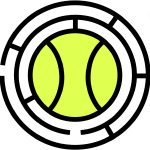Tennis as we know it is played on four types of surfaces – hard (Australian and US Open), clay (French Open), grass (Wimbledon), and carpet. I am of course generalizing the surfaces here not giving them the justice of their playing characteristics.
What if I were to tell you there is a fifth surface that is available to only a few countries? It’s soft under the feet but it’s too prickly to walk barefooted. There is white sand on it but not enough to slide like on clay but slippery enough that you can’t get a firm grip on the footing. When you hit a kick serve, the ball kicks up and outward away from the power house. And when you slice, the ball skids. But when you hit flat it slows down the pace. Crazy right?
Here we are in Fukuoka at a professional tournament playing on this rarely seen surface called the Omni Pro Court. A surface where no one other than the Japanese players has ever set foot on. So, how does one adapt to a surface that is completely unfamiliar? How does one adapt from different surfaces?
There are three things you can do to quickly and successfully acclimatize.
One: Build trust with your feet
Footing is a big part in getting set up properly for your shots. You want to be in the best balance that you can be to hit a solid shot. In order to be balanced, you have to be able to move. Good movements come from trusting the ground that you can push off or change directions as quickly as possible. What I like to do when approaching a different surface is to establish ground work with movements and agilities on the court without hitting. With the more advanced players, we will incorporate several movements with their eyes closed to quickly establish a trusting connection between their feet and the ground. Please do not try this at home.
Two: Returns, returns, returns
Did you know there is one commonality that you and Federer share? Or you and Serena Williams share? That is y’all have to start the point. when playing matches. Federer has to start the point. And so does Serena. You serve to start the point. You return to start the point. Returns have a technique of its own that needs refining but largely neglected. A good rule of thumb to practice your returning is to let your hitting partner serves from the deuce side follow by the ad side while you get to practice your returns the whole time before switching roles.
Three: Understanding court character
Every surface delivers challenges and triumphs to different players. While a certain style of play is more conducive to a particular surface it does not mean you are doomed from success if you don’t have the compatible style of play. Understanding the characteristics of how the ball moves after it hits the ground should give you great insights to which tools to use to be the most effective. For example, with the Omni courts, using variations on the serves with kick and slice were more effective than flat serves. That is not to say we never use the flat serves, it gets thrown in to mix things up as needed.
Tune in tomorrow for Day 3.


